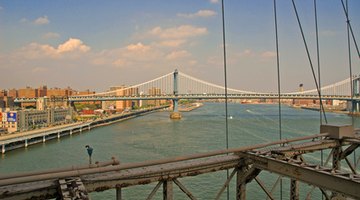The Disadvantages of Wooden Bridges
Wood is one of the oldest and most resilient bridge materials. Its extended use, however, increases the likelihood of damage. Regular maintenance is required to ensure the safety of a wooden bridge, but maintenance often suffers in times of financial constraint, increasing the likelihood of a failed bridge.

Increased Susceptibility to Damage
Wooden bridges are susceptible to damage caused by vandals, decomposition, misuse, mechanical problems and extreme weather conditions, all of which can compromise the structural integrity of the wooden bridge. The type of wood used in construction has to be treated annually with anti-weather and preservative coatings. Wood structures decay rapidly in the absence of proper treatment. Commonly used wood preservatives include creosote, pentachlorophenol and copper naphthenate.
Biotic Deterioration
Wood is an organic material and serves as a food source for some animals and plants. Certain insects, including marine borers, carpenter ants, powderpost beetles and termites, and fungi, digest cellulose and other fibrous elements that make up wood. Fungi causes substantial decay while insects drill holes, compromising the structural integrity of a wooden bridge. Biotic deterioration is addressed by applying preventive coating, fungicides, and oil-borne or oil-based wood preservatives to the surface of the wooden bridge.
Abiotic Deterioration
Wood is a combustible material, meaning it can catch fire easily. A wooden bridge is a fire hazard if constructed near a fuel source. Regular inspection of the surrounding area will ensure that no dangerous fuel sources are present in the vicinity. Fire retardants such as water soluble salts (ammonium tetraborate and diammonium phosphate) and chemicals are reinforced in the wood structure to prevent the potential danger of a fire outbreak.
Need for Frequent Maintenance
Wooden bridges require upkeep that is specific to wooden structures, such as applying fumigants, surface treatments and practicing moisture control. Effective bridge maintenance extends the life of the wooden structure, improves public safety and reduces the cost of major repair work required. Maintenance performed on wooden bridges includes preventative maintenance, remedial maintenance and major maintenance. Preventative maintenance requires that the bridge structure be in a good state to eliminate the chance of future problems. This is the stage where wood decay and deterioration has not set in but the potential for their occurrence exists. Early remedial maintenance is undertaken at the first signs of deterioration, decay or other structural flaw. Corrective action eliminates the chance of severe structural damage from occurring. Major maintenance is performed when it becomes necessary to restore the bridge to its original state.
References
Writer Bio
Natasha Gilani has been a writer since 2004, with work appearing in various online publications. She is also a member of the Canadian Writers Association. Gilani holds a Master of Business Administration in finance and an honors Bachelor of Science in information technology from the University of Peshawar, Pakistan.
Photo Credits
- bridge image by Brett Bouwer from Fotolia.com
- bridge image by Brett Bouwer from Fotolia.com
More Articles



